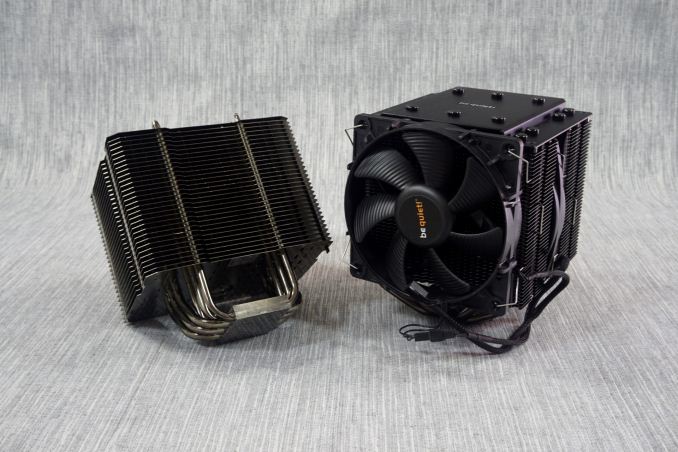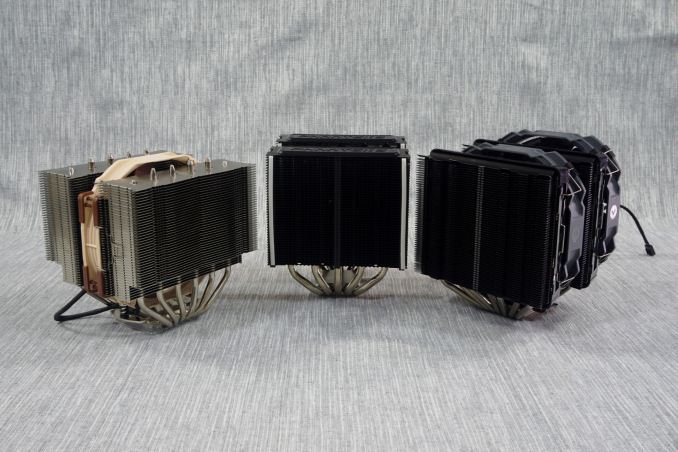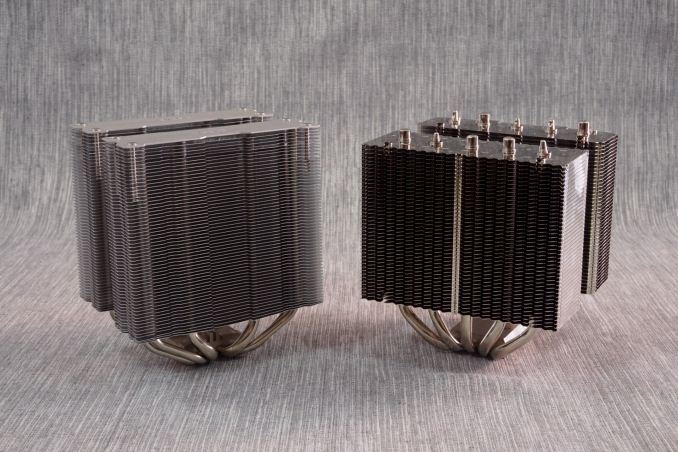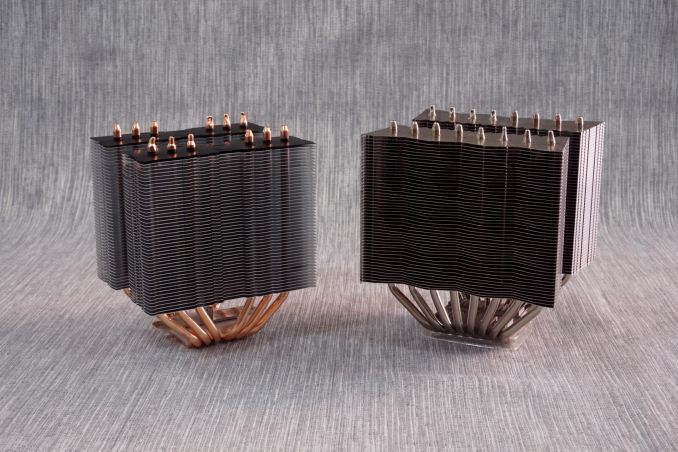Top Tier CPU Air Coolers Q3 2015: 9-Way Roundup Review
by E. Fylladitakis on July 6, 2015 8:00 AM ESTConclusion
It goes without saying that the selection of a CPU cooler is not easy. Each user has different requirements and needs. Even if we select a very specific group, such as those who are seeking the best air-based cooling solutions possible, there are different levels of tolerance to noise and different budgets. Furthermore, certain coolers could cause compatibility problems with the case or the RAM. All performance and physical aspects need to be taken into account by each individual user, weighing which option is the best for a specific application.
If thermal performance were the top priority, it would be very difficult to select between the Noctua NH-D15, the Cryorig R1 Ultimate, the Phanteks TC14PE and the Raijintek Tisis. All four of these coolers have similar thermal performance overall, with the Tisis and the NH-D15 showing a little better performance at lower loads and slightly lower noise levels. All four of these coolers are of comparable manufacturing quality as well; at least as long as the body of the cooler is concerned. A selection between these four coolers generally becomes a matter of compatibility, availability and pricing.
Noctua and Phanteks are known for their support and their willingness to offer mounting kits for new sockets, plus their design allows their front fans to be raised and increase the RAM clearance, gaining several points on compatibility. Cryorig's R1 Ultimate is visually very lustrous but its availability is extremely low. Furthermore, its plastic frame design prevents the fan to be moved up more than a few mm's, limiting RAM compatibility beneath the cooler. The Raijintek Tisis has the advantage of lower pricing but its availability is limited and its fans cannot be adjusted in terms of height at all.
When thermal performance becomes the only priority, the Reeven Okeanos overtakes the competition through sheer force. The relatively small and simple cooler hits the top of our thermal resistance charts, demonstrating the best thermal performance of this roundup review. However, this performance is solely based on its high speed fans, making the Okeanos by far the loudest cooler of this review as well. Furthermore, its availability is very low as Reeven still has very low market penetration and production. It would be easy to recommend the Okeanos to those who do not care about noise at all, but the blunt truth is that everyone does care about noise. It may not be the first priority but it definitely is a major selling factor, as nobody likes a noisy device, limiting the potential of the Okeanos.
Be Quiet!'s Dark Rock Pro 3 is clearly designed with acoustics and quality as the priorities, which generally are the focus and trademark of the company. It may be falling a little behind on thermal performance but it does deliver the promised lower noise levels. Furthermore, it is a high quality construct and comes with very high quality fans, improving its competitiveness. The acoustics performance of the Dark Rock Pro 3 is only challenged by the irregularity of our review, the Thermalright Macho Zero, a cooler designed for very low airflow environments. When paired with Thermalright's own TY-147A fan, the Macho Zero cannot offer the same thermal performance as the rest of the coolers but it is practically noiseless. Its wide fin spacing has very low airflow impedance, making the cooler optimized for semi-fanless operation. This means that the Macho Zero is designed to rely on the airflow of a case and operate without a fan at all, or to operate with a high-CFM case fan installed on it. Because of the low airflow impedance, the noise level of the Macho Zero is notably lower than that of conventional coolers, while it does offer good thermal performance. For those that acoustics are a primary concern, the Macho Zero definitely holds a major advantage.
The last two coolers of this review are the SlientiumPC Grandis XE1236 and the Deepcool Assassin. The former is by far cheaper than any other solution of this review and, considering its thermal performance, we wonder if it would be more reasonable to compare it against middle-range coolers, not the largest and mightiest behemoths out there. The only real comparison with the rest of the coolers in this review is its size and dual tower design. SilentiumPC however does not exaggerate, openly claiming that the primary design factor of their products is cost. True enough, the Grandis XE1236 is very competitively priced and offers acceptable overall performance, making it a very interesting solution for users on a tight budget. The Deepcool Gamerstorm Assassin is a more complicated matter. The design, size and, until recently, the price of this cooler were hinting that the Assassin is on par with the best coolers out there. However, despite its grandiose appearance, the Assassin generally fails to impress and it would be in great trouble if a massive price cut would not take place just a few days ago. With its retail price reduced by 25-30%, the Assassin becomes a viable solution, competing in terms of value rather than performance, making it a higher quality solution over the Grandis at an acceptable cost.
Ultimately, if our conclusions could be summarized in a single table, it would be this:
| 9-Way CPU Cooler Quick Conclusions | |||
| Priority | Cooler | Reason | |
| Best Thermal Performance |
Noctua NH-D15 $93 |
Reeven Okeanos 60€ (≈$54*) |
If raw thermal performance is the only concern, these two air-based coolers offer the best there is. Arguably, the Okeanos is far too loud but, even though the high performance solely comes from strong fans, it retails for nearly half the price of the NH-D15. Therefore, the final selection depends on secondary targets and the budget. |
| Quietest | Thermalright Macho Zero $65 (no fan) |
Be Quiet! Dark Rock Pro 3 $86.50 |
When low noise is the primary selection factor, Thermalright wins hands down. Be Quiet!'s Dark Rock Pro 3 would be our next choice, as it is a complete solution with fans and offers better thermal performance at comparatively low noise levels. |
| Best Value | SilentiumPC Grandis XE1236 £34.90 (≈$45*) |
Phanteks TC14PE $80 |
Out of the nine coolers of this review, the Grandis may not be the best performer but it is by far the cheapest. For those that are satisfied with good performance and just want a good cooler, it will not disappoint. For those in the US, Phanteks' TC14PE offers very good quality and performance at a competitive price. |
| Realistic selection (or what I, as an enthusiast/overclocker, would buy) |
Noctua NH-D15 $93 |
To my eyes, Noctua's NH-D15 is the most balanced product of this review. It offers excellent thermal performance at reasonable noise levels, the quality is exceptional, all while the retail price is not extravagant. | |














135 Comments
View All Comments
MartenKL - Monday, July 6, 2015 - link
I would of course like to see the testbed updated to have fan/s controlled by thermals, ie something like ASUS Fan Expert. Set for a target temperature and loads in the more realistic range of 15-150 watts. And of course when reducing voltage it should be via PWM and not simply reducing static voltage. The results should then be presented in temperature variance and noise levels/profile.MrSpadge - Monday, July 6, 2015 - link
Good suggestions. I hate those charts with "full fan voltage" and "fan voltage reduced to ..". What I really care about is "how silent can the cooler be for a given temperature / cooling performance?" And "which one cools better at similar noise level".It doesn't help much to see a strong fan with inbearable noise in those charts. Even if someone is interested in such solutions - wouldn't his question rather be "which heatsink performs best with this high-speed fan"? Which would again be something he couldn't answer from this data.
I know making noise based comparisons is difficult. But the raw sound pressure could be accompanied by some subjective remarks regarding the noise spectrum.
Cookiespy - Monday, July 6, 2015 - link
It would be interesting to see how the stock coolers compare to this high performance cooler. I wouldn't pay $80-100 just to see 5degrees improvement.Eidigean - Monday, July 6, 2015 - link
Chips big enough to need these coolers, such as Socket 2011, do not come with stock coolers.meacupla - Monday, July 6, 2015 - link
The stock heatsink cools great and is pretty silent with stock settings in a case with decent airflow, end of story.These kinds of $80 heatsinks are what you want when you overclock, but with the same or lower noise levels.
If you don't overclock, then a $20~25 heatsink can do a 5~20C improvement and keep the computer quieter at the same time too.
Eidigean - Monday, July 6, 2015 - link
What are you, a shill for Intel? The Intel stock heatsinks are the absolute worst. Check out the graphs from this Anandtech article:http://www.anandtech.com/show/6830/cpu-air-cooler-...
Dead last in performance AND noise. Stock heatsink was greater than 30 degrees C hotter, and 20 decibels louder.
meacupla - Monday, July 6, 2015 - link
It says right there in the system specs used to test those coolers..."Intel Core i7-2700K overclocked to 4.4GHz @ 1.4V"
I'm surprised the stock intel heatsink was able to complete the tests.
meacupla - Monday, July 6, 2015 - link
no wait, look, it says the stock heatsink and a low profile heatsink failed on an overclocked i7.Like I said, stock intel heatsink, especially the one with a copper core, works great at stock speeds.
Azurael - Friday, July 17, 2015 - link
I don't know if the stock HSFs have changed since Sandy Bridge, but my 2500k would hit 98+ degrees and throttle under AVX loads with the pathetic little stock thing whilst sounding like a small tornado had developed inside my case (how is it that a 95w CPU comes with an HSF half the size of the ones they used to ship with 65w C2Ds?!)Whichever cheap tower cooler I replaced it with does the job just fine, though. It's been running like a champ at 4.5GHz for near enough 4 years now. (I think it's a Xigmatek SD1283 - I haven't even taken the side off my machine for over a year, those heady days of tinkering and yearly upgrades long since passed.)
bug77 - Monday, July 6, 2015 - link
What, no mention of the weight of each cooler? I think that's a rather important aspect.